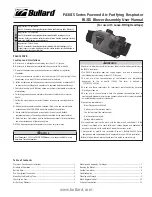
Page 30 of 36
P/N 595225-01 Rev C 4/12
WARNING
Y O U W I L L N O T O B TA I N E I T H E R
C Y L I N D E R ’ S R A T E D D U R A T I O N
AFTER TRANSFER WITH THE RIC UAC
AIRLINE ASSEMBLY. THE AMOUNT OF
AIR TRANSFERRED WILL ALWAYS BE
LESS THAN EITHER CYLINDER RATING.
FAILURE TO MONITOR THE AIR GAUGE
OF THE RESPIRATOR CYLINDER AND
VALVE ASSEMBLY AND/OR FAILURE TO
MAINTAIN EFFECTIVE COMMUNICATIONS
WITH THE RESPIRATOR USER MAY
RESULT IN SUDDEN AND UNEXPECTED
TERMINATION OF THE AIR SUPPLY TO THE
USER OF THE RESPIRATOR AND LEAD TO
SERIOUS INJURY OR DEATH.
a) If the air pressure in the RIT-PAK III portable air supply cylinder is higher
than the air pressure in the respirator cylinder, air will immediately begin
to flow from the portable air supply cylinder to the respirator cylinder.
The remote gauge on the respirator will begin to show an increase in
pressure.
NOTE
THE RIC UAC MANIFOLD IS FITTED WITH A RELIEF VALVE TO VENT AIR IF THE
RATED PRESSURE OF THE RESPIRATOR IS EXCEEDED. IF THIS OCCURS, CLOSE
THE CYLINDER VALVE ON THE RIT-PAK III PORTABLE AIR SUPPLY AND CHECK
THE PRESSURE ON THE RESPIRATOR CYLINDER GAUGE. WHEN THE EXCESS
PRESSURE HAS VENTED, THE RELIEF VALVE WILL RESET.
NOTE
IF AT ANY TIME DURING THE FILLING PROCESS A LEAK IS DETECTED, IMMEDIATELY
DISCONTINUE THE FILLING PROCEDURE AND FIND ANOTHER METHOD OF SUP
-
PLYING AIR TO THE RESPIRATOR USER.
b). The air will stop flowing when the respirator SCBA cylinder and the SCOTT
RIT-PAK III air supply reach the same pressure. The remote pressure
gauge on the SCBA respirator will stabilize at a reading less than “full”
at this time. There may still be air in the SCOTT RIT-PAK III portable
air supply cylinder. Close the cylinder valve on the SCOTT RIT-PAK III
portable air supply.
NOTE
WHEN THE SCOTT RIT-PAK III PORTABLE AIR SUPPLY IS USED WITH THE HIGH
PRESSURE AIR SUPPLY HOSE TO RECHARGE A DEPLETED CYLINDER, YOU WILL
NOT OBTAIN EITHER CYLINDER’S RATED DURATION AFTER THE TRANSFER. THE
AMOUNT OF AIR TRANSFERRED TO THE CYLINDER BEING CHARGED IS DEPENDENT
ON THE SIZE OF THE CYLINDER AND THE AMOUNT OF AIR LEFT IN THE CYLINDER
BEING CHARGED AND WILL ALWAYS BE LESS THAN EITHER CYLINDER RATING. SEE
THE SERVICE LIFE SECTION ON PAGE FOUR OF THIS INSTRUCTION.
12. When charging is complete, disconnect the HIGH pressure air supply hose
from the RIC UAC coupling on the respirator by pulling the coupling sleeve
away from the respirator until the coupling disengages. A check valve in the
RIC UAC coupling on the respirator will prevent air from flowing out of the
SCBA cylinder.
WARNING
NEVER CHARGE A CYLINDER TO MORE
THAN THE RATED PRESSURE MARKED
ON THE CYLINDER. OVERCHARGING
A CYLINDER MAY CAUSE A FAILURE
RESULTING IN RAPID RELEASE OF HIGH
PRESSURE AIR WHICH COULD CAUSE
SERIOUS INJURY OR DEATH.
WARNING
IF AT ANY TIME DURING THE FILLING
P R O C E S S A L E A K I S D E T E C T E D ,
IMMEDIATELY DISCONTINUE THE FILLING
P R O C E D U R E A N D F I N D A N O T H E R
METHOD OF SUPPLYING AIR TO THE
RESPIRATOR USER. CONTINUING TO FILL
A RESPIRATOR THAT HAS EXHIBITED
A LEAK MAY CAUSE A FAILURE OF THE
EQUIPMENT WHICH MAY RESULT IN
SERIOUS INJURY OR DEATH.
WARNING
S C O T T R I T - P A K
III
PORTABLE AIR
SUPPLY IS EQUIPPED WITH A BELL END-
OF-SERVICE ALARM AS WELL AS THE
LED DISPLAY TO SIGNIFY WHEN THE
CYLINDER HAS ONLY ONE QUARTER
OF ITS FULL CAPACITY REMAINING.
THE END-OF-SERVICE ALARM ON THE
USER’S RESPIRATOR MAY NOT OPERATE
NORMALLY WHEN BEING SUPPLIED BY
THE RIT-PAK
III
PORTABLE AIR SUPPLY.
FA I L U R E TO A S S I G N A P R O P E R LY
TRAINED PERSON TO MONITOR THE
AIR GAUGE OF THE CYLINDER AND
VALVE ASSEMBLY USED WITH THE
S C O T T R I T- PA K
III
P O R TA B L E A I R
SUPPLY AND/OR FAILURE TO MAINTAIN
EFFECTIVE COMMUNICATIONS WITH
THE RESPIRATOR USER MAY RESULT IN
SUDDEN AND UNEXPECTED TERMINATION
OF THE AIR SUPPLY TO THE USER OF THE
RESPIRATOR AND LEAD TO SERIOUS
INJURY OR DEATH.
HIGH PRESSURE AIR SUPPLY CONTINUED...
AFTER CHARGING THE USER’S BREATHING AIR CYLINDER
1. After charging is complete, monitor the cylinder pressure on the respirator
user’s cylinder gauge. If the user’s SCBA cylinder becomes depleted before
evacuation is complete, repeat the charging process with a RIT-PAK III por-
table air supply equipped with a full cylinder.
NOTE
THE END-OF-SERVICE ALARM ON THE RESPIRATOR MAY NOT OPERATE NORMALLY
WHEN BEING SUPPLIED BY THE RIT-PAK III PORTABLE AIR SUPPLY. A MEMBER OF
THE TEAM MUST MONITOR THE AIR SUPPLY FOR THE RESPIRATOR USER UNTIL
THE RESCUE IS COMPLETE.
2. Leave the area requiring respiratory protection as quickly as possible as
prescribed by your organized respiratory protection program. If, during use
of the respirator, breathing becomes difficult for the respirator user, the air
supply stops or any other difficulty is encountered, identify and correct the
problem immediately. If necessary, find another source of breathing air for
the respirator user until the evacuation can be completed.
CAUTION
OVERTIGHTENING THE CYLINDER VALVE
MAY CAUSE DAMAGE THAT COULD
RESULT IN LEAKAGE OF AIR FROM THE
CYLINDER. USE NO TOOLS TO CLOSE THE
CYLINDER VALVE.







































